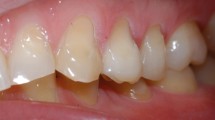Abstract
Carrageenan has been used in the laboratory for decades because it reliably causes inflammation. Coincident with its use in the laboratory, carrageenan has been used in an ever-increasing list of processed foods, as well as in infant formula, pharmaceuticals, cosmetics, toothpaste, room air deodorizers, and other products. The biological reactivity of carrageenan makes it a useful substance to improve the texture and solubility of ingredients in processed foods. Individuals may consume several grams of carrageenan on a daily basis. However, the potential contribution of carrageenan exposure to chronic human diseases, due to its activation of immune responses and its potent inflammatory properties, must be recognized.
Similar content being viewed by others
References
Bhattacharyya S, O-Sullivan I, Katyal S, Unterman T, Tobacman JK (2012) Exposure to the common food additive carrageenan leads to glucose intolerance, insulin resistance and inhibition of insulin signalling in HepG2 cells and C57BL/6J mice. Diabetologia 55:194–203
Bhattacharyya S, Feferman L, Unterman T, Tobacman JK (2015) Exposure to common food additive carrageenan alone leads to fasting hyperglycemia and in combination with high fat diet exacerbates glucose intolerance and hyperlipidemia without effect on weight. J Diabetes Res 2015:513429
Bhattacharyya S, Shumard T, Hui X, Dodda A, Feferman L, Halline A, Goldstein J, Hanauer SB, Tobacman JK (2016) Effects of the no carrageenan diet on ulcerative colitis disease activity: a pilot and feasibility study. Gastroenterology 150:S777
Bhattacharyya S, Shumard T, Xie H, Dodda A, Varady KA, Feferman L, Halline AG, Goldstein JL, Hanauer SB, Tobacman JK (2017) A randomized trial of the effects of the no-carrageenan diet on ulcerative colitis disease activity. Nutr Health Aging 4:181–192
Bixler H (2013) Refuting myths about carrageenan. Food Processing. http://www.foodprocessing.com/articles/2013/refuting-myths-about-carrageenan/
Bixler HJ (2017) The carrageenan controversy. J Appl Phycol. doi:10.1007/s10811-017-1132-4
European Commission (2003) European commission - health & consumer protection directorate-general. Scientific committee on food SCF/CS/ADD/EMU/199.Opinion of the Scientific Committee on Food on Carrageenan, March 3, 2003.
Federal Register (1972) Proposed revision of food additive regulations and deletion of Chondrus extract (carrageenin) from Generally Regarded as Safe (GRAS) List. 37 Fed Reg 15434
Federal Register (1979) Carrageenan, salts of carrageenan and Chondrus extract (carrageenin); withdrawal of proposal and termination of rulemaking proceeding. Fed Reg 44:40343–40345
JECFA (2007) Joint FAO/WHO Expert Committee on Food Additives Sixty-eight meeting. Summary and conclusions JECFA/68/SC, Geneva
Macher BA, Galili U (2008) The Gal-α-1,3-Gal-β-1,4-GlcNAc-R (α-Gal) epitope: a carbohydrate of unique evolution and clinical relevance. Biochim Biophys Acta 1780:75–88
Marinalg Working Group on Molecular Weight Determination (Blakemore W, Bixler H, Graff Anderson A, de Vries J, Boulenguer P) (2006) Technical position on measurements related to meeting the EC molecular weight distribution specification for carrageenan and PES. Report. Annex 1 and Annex 2
McKim JM Jr, Wilga PC, Pregenzer JF, Blakemore WR (2015) The common food additive carrageenan is not a ligand for toll-like-receptor 4 (TLR4) in an HEK293-TLR4 reporter cell-line model. Food Chem Toxicol 78:163–168
McKim JM Jr, Baas H, Rice GP, Willoughby JA Sr, Weiner ML, Blakemore W (2016) Effects of carrageenan on cell permeability, cytotoxicity, and cytokine gene expression in human intestinal and hepatic cell lines. Food Chem Toxicol 96:1–10
National Organic Standards Board (NOSB) (2016) OTA’s summary report. http://www.ota.com
Spichtig V, Austin S (2008) Determination of the low molecular weight fraction of food-grade carrageenans. J Chromatogr B 861:81–87
Tanemura M, Yin D, Chong AS, Galili U (2000) Differential immune responses to α-gal epitopes on xenografts and allografts: implications for accommodation in xenotransplantation. J Clin Invest 105:301–310
Tobacman JK (2003) Toxic considerations related to ingestion of carrageenan. In: Preedy V, Watson RP (eds) Reviews in food and nutrition toxicity. Taylor and Francis, New York, pp 204–229
Weiner ML, Ferguson HE, Thorsrud BA, Nelson KG, Blakemore WR, Zeigler B, Cameron MJ, Brant A, Cochrane L, Pellerin M, Mahadevan B (2015) An infant formula toxicity and toxicokinetic feeding study on carrageenan in preweaning piglets with special attention to the immune system and gastrointestinal tract. Food Chem Toxicol 77:120–131
Author information
Authors and Affiliations
Corresponding author
Rights and permissions
About this article
Cite this article
Tobacman, J.K. Reply to comments regarding “The Carrageenan Controversy”. J Appl Phycol 29, 2209–2211 (2017). https://doi.org/10.1007/s10811-017-1145-z
Received:
Revised:
Accepted:
Published:
Issue Date:
DOI: https://doi.org/10.1007/s10811-017-1145-z




